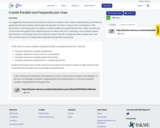
It is suggested that this activity be used once students have a deep understanding of parallel and perpendicular lines. Students will be given the equation of a line in various forms and based on that information, must drag points on a graph to create parallel and perpendicular lines. Initially students will not be shown the graph of the original line, but can obtain that hint if necessary. Once students submit their solutions on the graph, they can reveal the answer, but will no longer be able to adjust their work. This could be used as an assessment, especially during distance learning.
- Subject:
- Measurement and Geometry
- Material Type:
- Activity/Lab
- Homework/Assignment
- Interactive
- Author:
- Kaitlin Bookbinder
- Date Added:
- 11/16/2020
